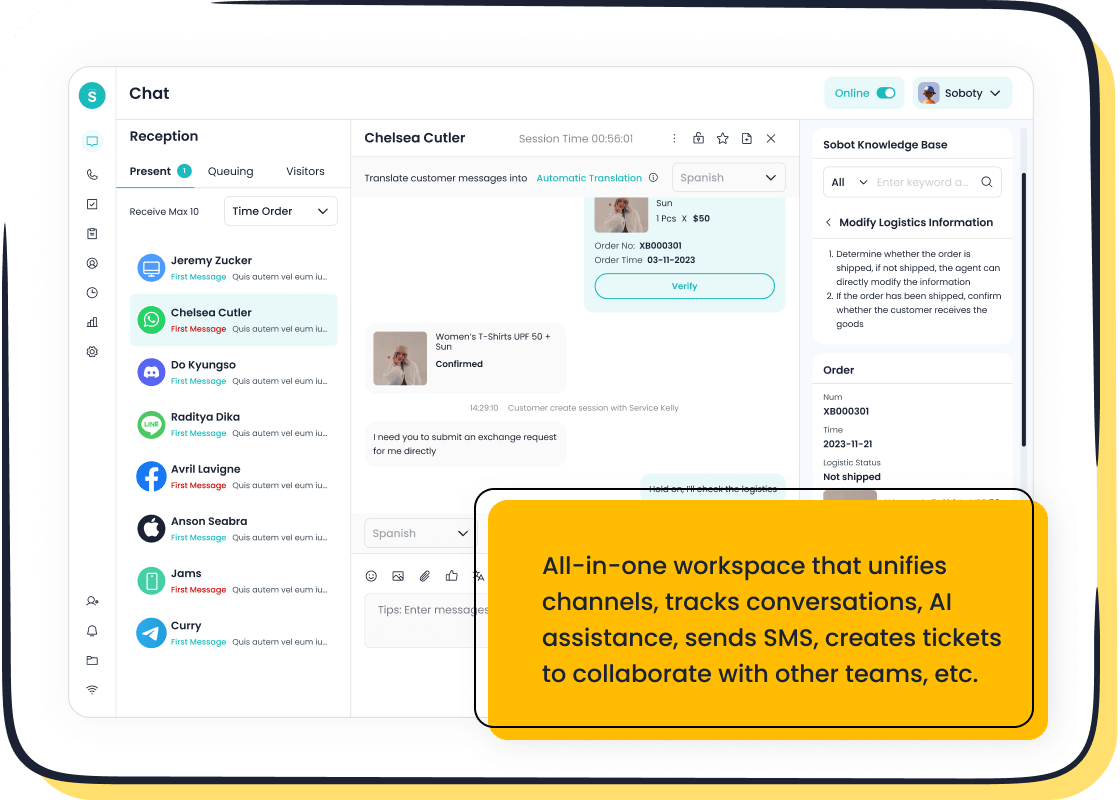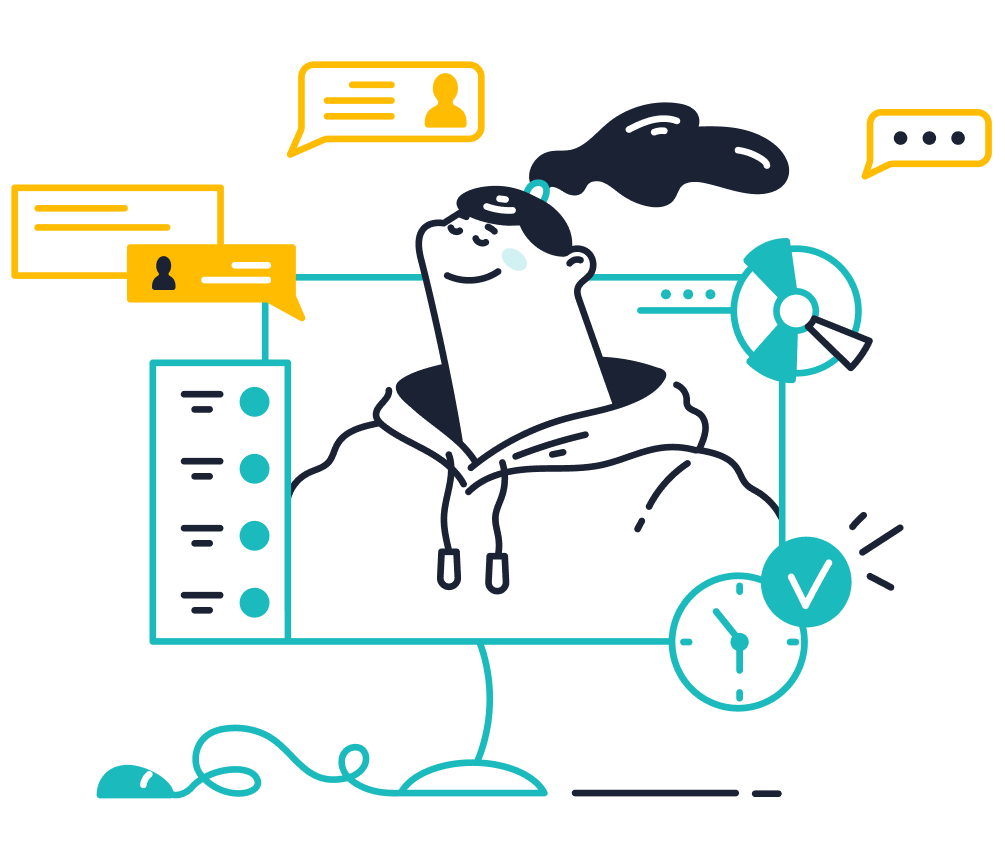Boost Ecommerce Conversion Rates with These Steps

Ecommerce conversion rates play a vital role in determining the success of your online business. They measure how effectively your website turns visitors into paying customers. For instance, the Food & Beverage sector boasts the highest conversion rate at 4.9%, while Home & Furniture lags at 1.4%. These numbers highlight the importance of optimizing your site to stay competitive.
Improving conversion rates not only increases revenue but also enhances customer satisfaction. When more visitors become loyal buyers, your business grows sustainably. Tools like Sobot can help you understand how to improve ecommerce conversion rate by offering tailored solutions that maximize customer engagement and profitability.
Understanding Ecommerce Conversion Rates
What Are Ecommerce Conversion Rates
Ecommerce conversion rates measure how effectively your website turns visitors into customers. This metric reflects the percentage of users who complete a desired action, such as making a purchase, signing up for a newsletter, or downloading a resource. For example, if 100 people visit your site and 5 make a purchase, your conversion rate is 5%.
Several factors influence ecommerce conversion rates, including website performance, mobile optimization, and the checkout experience. High cart abandonment rates, slow page load times, and insufficient product information can negatively impact your results. Understanding these factors helps you identify areas for improvement and boost your business performance.
How to Calculate Ecommerce Conversion Rates
Calculating ecommerce conversion rates is straightforward. Use the formula:
Conversion Rate = (Number of Conversions / Total Number of Visitors) × 100
For instance, if your store receives 200 visitors and 50 of them make a purchase, your conversion rate is:
(50 / 200) × 100 = 25%
This calculation applies to various actions, such as purchases, form submissions, or downloads. Regularly tracking this metric allows you to monitor performance and make data-driven decisions. Tools like Google Analytics simplify this process by providing detailed insights into visitor behavior and conversion trends.
What Is a Good Ecommerce Conversion Rate
A good ecommerce conversion rate typically ranges between 1% and 2%. However, this varies by industry. For example:
| Industry | Average Conversion Rate |
|---|---|
| Fashion and apparel | 2.5% - 3.5% |
| Electronics | 1.5% - 2.5% |
| Beauty and cosmetics | 3.0% - 4.0% |
| Home and furniture | 2.0% - 3.0% |
| Luxury goods | 1.0% - 1.5% |
Recent data shows that the Food & Beverage sector achieves the highest conversion rates at 4.9%, while Home & Furniture lags at 1.4%. These benchmarks highlight the importance of tailoring your strategies to your specific industry. By aligning your goals with these standards, you can set realistic expectations and measure success effectively.

"By uploading Point Of Sale information to Google, retailers can now match in-store purchasers with online ad clickers, gaining further visibility on the success of their campaigns. The results speak for themselves: digital marketers saw an extra 168% in revenue in their in-store sales, on top of what was made online."
Step 1: Optimize Your Product Pages to Increase Ecommerce Conversion Rates

Use High-Quality Product Images and Videos
Visuals play a crucial role in ecommerce. High-quality product images and videos help customers understand your offerings better. They also make your website more engaging. Studies show that 71% of American consumers are more likely to buy a product when they see user-submitted photos. Additionally, 84% of people have been convinced to purchase something after watching a video. For instance, DueMaternity.com increased their conversion rate by 27% after optimizing their product images.
Videos can demonstrate how your product works or highlight its unique features. This approach not only boosts sales but also improves the shopping experience. Marketers report that video content has directly helped increase sales by 78%. By investing in professional visuals, you can create a lasting impression and encourage more purchases.
Write Persuasive Product Descriptions
Your product descriptions should do more than just list features. They should tell a story that connects with your audience. Nearly 90% of consumers consider product content very important when deciding to buy. Poorly written descriptions can lead to returns, with 64% of users citing this as a reason for sending items back.
Focus on benefits rather than just features. Use simple language to explain how your product solves a problem or meets a need. For example, a redesign that addressed customer concerns led to a 68.6% increase in sales. Clear and persuasive descriptions can make your products more appealing and drive conversions.
Showcase Customer Reviews and Testimonials
Customer reviews and testimonials build trust. They show potential buyers that others have had positive experiences with your products. Research reveals that 89% of global consumers check reviews before making a purchase. Highlighting user-generated content, such as photos or video testimonials, adds credibility to your brand.
Social proof is a powerful tool in ecommerce. Authentic reviews and testimonials should be prominently displayed on your product pages. Nearly half of consumers rank reviews among the top three factors influencing their buying decisions. By showcasing these, you can increase ecommerce conversion rates and foster customer confidence.
Step 2: Simplify the Checkout Process for Better Conversion Rate Optimization

Reduce Checkout Steps to Minimize Friction
A lengthy checkout process often frustrates customers, leading to cart abandonment. Studies reveal that 21% of online shoppers leave a site due to a complicated or time-consuming checkout. The average checkout flow includes 12 form fields, but reducing this to 7 or 8 fields can significantly improve the experience. Every additional step increases the likelihood of abandonment, so streamlining the process is crucial.
Focus on eliminating unnecessary steps. For example, instead of requiring customers to create an account, allow them to proceed directly to payment. This small change can lead to measurable improvements in conversion rates. Simplifying the checkout process not only reduces friction but also enhances customer satisfaction, encouraging repeat purchases.
Offer Guest Checkout and Multiple Payment Options
Forcing customers to register before completing a purchase can deter them. Offering a guest checkout option removes this barrier, making the process faster and more convenient. Statistics show that providing guest checkout can prevent cart abandonment and improve conversion rates.
Additionally, offering multiple payment methods caters to diverse customer preferences. The right payment options can boost conversion rates by up to 30%. Providing choices like credit cards, digital wallets, and buy-now-pay-later services reduces friction and increases the likelihood of completing a sale. A variety of payment methods ensures that your ecommerce store accommodates all customers, enhancing their overall experience.
Use Sobot Live Chat to Assist Customers in Real-Time

Real-time assistance during the checkout process can make a significant difference. Sobot Live Chat provides instant support, helping customers resolve issues like payment errors or confusion about shipping options. This tool reduces inbound discussion volume by 20% and achieves a customer satisfaction rate of over 95%.
By integrating Sobot Live Chat, you can address customer concerns immediately, preventing them from abandoning their carts. The platform’s AI-powered tools deliver accurate answers 80% of the time, ensuring a seamless experience. Businesses using Sobot Live Chat report a 35% increase in sign-off rates and a 40% boost in cash-on-delivery collections. These results highlight the value of real-time support in improving ecommerce conversion rates.

Step 3: Improve Website Performance to Boost Ecommerce Conversion Rates
Enhance Page Load Speed for a Seamless Experience
Page load speed directly impacts your ecommerce conversion rates. Faster websites create a better user experience, encouraging visitors to stay and complete purchases. Studies show that web pages loading in 2.4 seconds achieve an average conversion rate of 1.9%. However, when load time increases to 4.2 seconds, the conversion rate drops below 1%. B2C ecommerce sites that load in 1 second see conversion rates 2.5 times higher than those taking 5 seconds.
Even a one-second delay can significantly affect conversions. The table below highlights the impact of load time delays:
| Load Time Delay | Effect on Conversions |
|---|---|
| 1 second | 7% decrease |
| 3 seconds | 20% decrease |
| > 3 seconds | 53% of mobile users abandon the page |
Optimizing your website's performance can yield impressive results. For example, Rakuten 24 increased its conversion rate by 33.13% after improving Core Web Vitals. To improve page loading speed, compress images, enable browser caching, and use a content delivery network (CDN). These steps ensure a seamless experience for your customers.
Ensure Mobile Responsiveness Across Devices
Mobile responsiveness is essential for ecommerce success. With 65% of shopping journeys starting on mobile, your website must perform well across all devices. Mobile visitors convert at a rate of 2.86%, and 46% of purchases are completed on mobile. Ensuring your site is mobile-friendly can significantly boost conversions.
Responsive design adjusts your website layout to fit any screen size. This approach improves usability and keeps visitors engaged. The chart below illustrates the impact of mobile responsiveness on conversion rates:

To optimize for mobile, test your site on various devices, simplify navigation, and ensure fast load times. These actions help you capture more mobile shoppers and increase sales.
Fix Broken Links and Address Errors
Broken links and errors frustrate users and harm your ecommerce conversion rates. When visitors encounter a 404 error or a non-functional link, they are more likely to leave your site. Regularly auditing your website helps you identify and fix these issues.
Use tools like Google Search Console to locate broken links. Replace outdated URLs with relevant ones or redirect users to functional pages. Addressing errors not only improves user experience but also boosts your site's credibility. A well-maintained website builds trust and encourages visitors to complete their purchases.
Step 4: Leverage Personalization and Retargeting to Improve Ecommerce Conversion Rates
Use Personalized Product Recommendations
Personalized product recommendations can significantly enhance the customer experience and drive ecommerce growth. By tailoring suggestions based on browsing history, purchase behavior, or preferences, you can simplify the decision-making process for your customers. This approach not only boosts engagement but also increases the likelihood of conversion.
For example, personalized recommendations contribute up to 31% of ecommerce revenues. Customers who interact with these suggestions are 4.5 times more likely to add items to their cart and complete a purchase. Additionally, the average order value (AOV) increases by 369% when users engage with recommendations. Amazon’s recommendation system, which accounts for 35% of its $514 billion revenue, highlights the effectiveness of this strategy.
| Metric | Value |
|---|---|
| Contribution to eCommerce revenues | Up to 31% |
| Likelihood to add items to cart after clicking recommendations | 4.5x more likely |
| Likelihood to complete purchase after clicking recommendations | 4.5x more likely |
| AOV with engagement | 369% increase |
By implementing personalized recommendations, you can personalize user experiences, increase sales, and foster customer loyalty.
Implement Retargeting Ads for Abandoned Carts
Cart abandonment is a common challenge in ecommerce, but retargeting ads can help you recover lost sales. These ads remind customers of the items they left behind and encourage them to complete their purchase. Retargeting campaigns are highly effective, with 26% of users returning to finish their checkout and a 70% likelihood of conversion when retargeted.
| Statistic Description | Value |
|---|---|
| Percentage of users returning to complete checkout | 26% |
| Likelihood of conversion when retargeted | 70% |
Retargeting also drives significant traffic and engagement. For instance, it increases branded search by 1046% and targeted site traffic by 726%. By showing relevant ads to potential buyers, you can address cart abandonment and improve your conversion rates.

Send Follow-Up Emails to Re-Engage Customers
Follow-up emails are a powerful tool for re-engaging customers and addressing cart abandonment. These emails remind users of their unfinished purchases and encourage them to return. Cart abandonment emails achieve an open rate of 40% to 45%, a click rate of approximately 50%, and a conversion rate of nearly 50% after clicking.
| Statistic | Value |
|---|---|
| Open rate of cart abandonment emails | 40% to 45% |
| Click rate of cart abandonment emails | ~50% |
| Conversion rate after clicking | ~50% |
To maximize effectiveness, use a sequence of emails. Start with a simple reminder, follow up with personalized offers or discounts, and conclude with a request for feedback or product recommendations. This strategy keeps your brand top-of-mind and encourages customers to complete their purchases.
Step 5: Use Data and Tools to Measure and Optimize Conversion Rates
Track Key Metrics Like Bounce Rate and Cart Abandonment
Tracking key metrics helps you understand how visitors interact with your site and where improvements are needed. Metrics like bounce rate, average session duration, and cart abandonment provide valuable insights into user behavior. For example, a high bounce rate might indicate issues with navigation or page relevance. Similarly, cart abandonment highlights problems in the checkout process, such as unexpected fees or complicated steps.
To calculate cart abandonment, divide the number of abandoned carts by the total carts created. If 500 carts were created and 150 were abandoned, the abandonment rate would be 30%. This metric helps you pinpoint areas where customers lose trust or face friction. By addressing these issues, you can improve the overall shopping experience and boost conversion rate optimization.
| Metric | Description |
|---|---|
| Bounce Rate | Indicates the percentage of visitors who leave after viewing only one page. |
| Average Session Duration | Measures the average time visitors spend on the site, indicating engagement levels. |
| Average Page Depth | Reflects how many pages a visitor views in a session, showing engagement before leaving. |
| Conversion Rate | The percentage of visitors who complete a desired action, such as making a purchase. |
Use Analytics Tools Such as Google Analytics and Sobot Live Chat
Analytics tools are essential for understanding your site's performance. Platforms like Google Analytics, Lucky Orange, and HotJar provide detailed data on visitor behavior. These tools help you identify trends, track key metrics, and make informed decisions to optimize your ecommerce site.
Sobot Live Chat offers additional advantages by providing real-time insights into customer interactions. It evaluates over 150 indicators, such as response times and satisfaction rates, to help you refine your strategies. With built-in analytics, Sobot Live Chat simplifies the process of tracking metrics like bounce rate and cart abandonment. This tool also enhances trust by offering personalized support, ensuring a seamless experience for your customers.
Conduct A/B Testing to Refine Strategies
A/B testing allows you to compare different versions of your website to see which performs better. For example, you can test two variations of a call-to-action button to determine which one drives more conversions. This method provides real data on what works and what doesn’t, helping you refine your strategies.
Brands that conduct A/B testing often see revenue gains of 50-200%. Experimenting with layouts, navigation, and calls-to-action can lead to surprising improvements in conversion rates. Tools like Shogun make it easy to set up and manage these tests. By continuously testing and optimizing, you can create a user experience that builds trust and encourages purchases.
Improving ecommerce conversion rates requires a strategic approach. Start by optimizing product pages with high-quality visuals, persuasive descriptions, and customer reviews. Simplify the checkout process to reduce friction and offer multiple payment options. Enhance website performance by improving load speed and ensuring mobile responsiveness. Personalize user experiences with tailored recommendations and retargeting ads. Use tools like Sobot Live Chat to provide real-time support and track key metrics like cart abandonment and bounce rate.
Continuous tracking and optimization are essential for long-term success. Experiment with layouts, adjust CTAs, and use A/B testing tools to refine your strategies. Faster website speeds alone can increase conversions by 7%, while loading in under two seconds can drive a 15% boost. These steps ensure you stay competitive and achieve a good ecommerce conversion rate.
Take action today. Implement these strategies and explore Sobot Live Chat to enhance customer engagement and drive results. Visit Sobot's website to learn more about their innovative solutions.
FAQ
What are the most common reasons for cart abandonment?
Cart abandonment often happens due to unexpected costs, complicated checkout processes, or limited payment options. Lack of trust, slow page load times, and poor mobile optimization also contribute. Addressing these issues can improve your conversion rates.
How can mobile optimization improve ecommerce conversion rates?
Mobile optimization ensures your site works seamlessly on smartphones and tablets. A mobile-friendly design enhances user experience, reduces bounce rates, and increases conversions. With most shopping journeys starting on mobile, this step is essential for success.
Do customer reviews really impact sales?
Yes, reviews build trust and influence buying decisions. Shoppers often rely on feedback to evaluate product quality. Highlighting positive reviews on your site can boost credibility and encourage purchases.
How do discounts affect customer behavior?
Discounts create urgency and attract price-sensitive shoppers. Limited-time offers or exclusive deals encourage quick decisions. They also help clear inventory and increase sales volume, making them a powerful tool for boosting conversions.
What tools can help track ecommerce performance?
Tools like Google Analytics and Sobot Live Chat provide valuable insights. They track metrics such as bounce rates, cart abandonment, and customer interactions. These tools help you identify areas for improvement and optimize your strategies effectively.
See Also
Increase Sales Through Effective Ecommerce Live Chat Tools
Improve Shopify Revenue Using Live Chat Features
A Guide to Implementing Live Chat on Shopify
